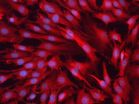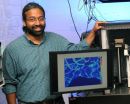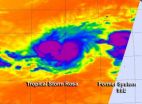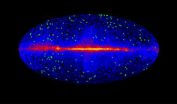(Press-News.org) PHILADELPHIA - Arterial stiffening has long been considered a major risk factor for cardiovascular disease. Keeping arteries soft and supple might reduce disease risk, but the mechanisms of how arteries stave off hardening has remained elusive.
Researchers from the Perelman School of Medicine, University of Pennsylvania, Wistar Institute, and The Children's Hospital of Philadelphia have discovered that the protein apolipoprotein E (apoE) plays a major role in maintaining arterial softness by suppressing production of the extracellular matrix, a network of connective tissue in the body. Their research appeared in the most recent issue of Cell Reports.
ApoE is a component of several lipoproteins, including HDL, the "good" cholesterol, and is generally believed to forestall atherosclerosis. But several recent major studies have questioned the link between HDL and cardiovascular protection. Meanwhile, other research involving cultured cells has indicated that apoE has effects beyond its role in regulating lipid levels as a component of HDL. The present work suggests that it may be the apoE-containing HDL that confers the main benefit of HDL by promoting arterial softness.
Analyzing genetic datasets of regular mice and mutant mice without apoE, the researchers showed definite differences in gene expression, with the apoE-null mice displaying marked increase in indicators of stiffening – the proteins collagen, fibronectin, and lysyl oxidase in response to stiffening in the aorta, which led to severe atherosclerosis. To attempt to mitigate the atherosclerosis seen in the apoE-null mice, the researchers fed them a high-fat diet and treated them with a lysyl oxidase inhibitor, which softened their arteries.
Despite highly elevated cholesterol, the mice showed a marked improvement in their atherosclerosis. The results suggest that the lack of apoE results in arterial stiffness, and that even with high cholesterol, increasing arterial elasticity by pharmacologic means can greatly reduce atherosclerotic disease.
"HDL can't be looked at as just one compound, because it is a mixture of different molecular components," explains senior author Richard K. Assoian, PhD, professor of Pharmacology. "The component that has these effects on arterial stiffening is a minor part of total HDL." Assoian notes that this could help to reconcile the conflicting clinical evidence regarding the link between HDL and reduced cardiovascular disease. "It might be the apoE HDL fraction that you need to keep high and not worry about the total HDL," he suggests. Because apoE is only about 6 percent of total HDL, "it could go up sky high or not at all, and you probably wouldn't detect it in these studies that try to raise total HDL."
The possibility of preventing or treating atherosclerosis by promoting arterial elasticity independent of cholesterol could be a boon for the many people unable to tolerate the statin drugs that are the usual treatment.
"Perhaps there are other routes that you could use, independent of cholesterol and statins, that could help keep atherosclerosis at bay," says co-first author Devashish Kothapalli, PhD. "We think controlling stiffening is one of those. We showed in the paper that even when cholesterol is remarkably high, if you soften tissues back to a healthy level, atherosclerosis is inhibited."
Targeting arterial stiffening could also provide added benefit for patients already on statins. "Ultimately we would hope that controlling stiffening could be used in conjunction with a statin for the large percentage of people who are already on statins but need extra help," says co-first author Shu-Lin Liu, PhD.
Although the current study demonstrates how apoE and apoE-containing HDL promote cardiovascular health by maintaining arterial softness, Assoian notes that a practical treatment would likely not target apoE, because it "does a lot of other things that you don't want to interfere with. So the goal in my mind would be to develop something that is really targeting stiffness but not affecting any of the lipid aspects of atherosclerosis that apoE and HDL control. The lysyl oxidase inhibitor drug we used in this study, BAPN, is good for proof of principle, but not useful on a practical level, because there are too many side effects."
INFORMATION:
This work was funded by the National Heart Lung and Blood Institute (Grants 66250, 22633, 56083, 093283)
Penn Medicine is one of the world's leading academic medical centers, dedicated to the related missions of medical education, biomedical research, and excellence in patient care. Penn Medicine consists of the Raymond and Ruth Perelman School of Medicine at the University of Pennsylvania (founded in 1765 as the nation's first medical school) and the University of Pennsylvania Health System, which together form a $4.3 billion enterprise.
The Perelman School of Medicine is currently ranked #2 in U.S. News & World Report's survey of research-oriented medical schools. The School is consistently among the nation's top recipients of funding from the National Institutes of Health, with $479.3 million awarded in the 2011 fiscal year.
The University of Pennsylvania Health System's patient care facilities include: The Hospital of the University of Pennsylvania -- recognized as one of the nation's top "Honor Roll" hospitals by U.S. News & World Report; Penn Presbyterian Medical Center; and Pennsylvania Hospital — the nation's first hospital, founded in 1751. Penn Medicine also includes additional patient care facilities and services throughout the Philadelphia region.
Softening arteries, protecting the heart
Underlying connection between 'good' cholesterol and collagen in heart health
2012-11-02
ELSE PRESS RELEASES FROM THIS DATE:
Iowa State, Ames Lab researchers find 3 unique cell-to-cell bonds
2012-11-02
AMES, Iowa – The human body has more than a trillion cells, most of them connected, cell to neighboring cells.
How, exactly, do those bonds work? What happens when a pulling force is applied to those bonds? How long before they break? Does a better understanding of all those bonds and their responses to force have implications for fighting disease?
Sanjeevi Sivasankar, an Iowa State assistant professor of physics and astronomy and an associate of the U.S. Department of Energy's Ames Laboratory, is leading a research team that's answering those questions as it studies ...
NASA adds up Hurricane Sandy's rainfall from space
2012-11-02
NASA's Tropical Rainfall Measuring Mission, or TRMM, satellite acts as a rain gauge in space as it orbits the Earth's tropics. As TRMM flew over Hurricane Sandy since its birth on Oct. 21 it was gathering data that has now been mapped to show how much rain the storm dropped along the U.S. eastern seaboard.
Much of the recent deadly flooding along the northeastern United States coastlines was caused by super storm Sandy's storm swell. Strong winds from Sandy persistently pushed Atlantic Ocean waters toward the coast. High tides that occurred at the same time also magnified ...
NASA sees Tropical Storm Rosa's rains southeast of center
2012-11-02
Wind shear is pushing the bulk of Tropical Storm Rosa southeast of the storm's center, and that's evident on infrared imagery from NASA's Aqua satellite. Meanwhile System 99E, that was trailing behind Rosa on Oct. 31, has now "given up the ghost" as a result of that same wind shear.
When NASA's Aqua satellite flew over Tropical Storm Rosa at 5:41 a.m. EDT (0951 UTC) on Nov. 1, 2012 the Atmospheric Infrared Sounder (AIRS) instrument took an infrared picture of Tropical Storm Rosa and remnants of System 99E. The AIRS data showed the strongest convection (rising air that ...
Trickle-down anxiety: Study examines parental behaviors that create anxious children
2012-11-02
Parents with social anxiety disorder are more likely than parents with other forms of anxiety to engage in behaviors that put their children at high risk for developing angst of their own, according to a small study of parent-child pairs conducted at Johns Hopkins Children's Center.
Authors of the federally funded study say past research has linked parental anxiety to anxiety in children, but it remained unclear whether people with certain anxiety disorders engaged more often in anxiety-provoking behaviors. Based on the new study findings, they do. A report on the team's ...
NASA sees Tropical Depression Nilam blanket southern India
2012-11-02
After Tropical Cyclone Nilam made landfall in southeastern India NASA's Terra satellite passed overhead and saw the storm's clouds blanket the entire southern portion of the country from Chennai southward.
On Nov. 1 at 05:50 UTC (1:50 a.m. EDT), the Moderate Resolution Imaging Spectroradiometer (MODIS) instrument that flies aboard NASA's Terra satellite captured a visible image of Tropical Depression Nilam.
The MODIS image showed that Nilam's clouds stretched as far north as Andra Pradesh, a state in east central India. It covered the states of Goa and Karnataka in ...
Church-going teens go further with school
2012-11-02
For many American teens, the road to college goes through the chapel.
Sociologists from Brigham Young University and Rice University found religiously-affiliated youth are 40 percent more likely to graduate high school than their unaffiliated peers and 70 percent more likely to enroll in college.
The researchers note that teens' fellow church-goers are an important factor, serving as mentors who help teens set their sights high.
"Youth have a unique chance to form relationships with peers and mentors outside of their classroom at school or their neighborhood at home," ...
Suomi NPP satellite captures Hurricane Sandy's Mid-Atlantic blackout
2012-11-02
The Suomi National Polar-orbiting Partnership (NPP) satellitecaptured a night-time view of New York City, New Jersey and eastern Pennsylvania that revealed the extent of the power outages caused from Hurricane Sandy's landfall on October 29. Suomi NPP is a partnership between NASA, the National Oceanic and Atmospheric Administration (NOAA), and the U.S. Department of Defense.
The Visible Infrared Imaging Radiometer Suite (VIIRS) on Suomi NPP captured a night-time view of the Mid-Atlantic on the morning of Nov. 1, 2012,revealing areas where power has not been currently ...
NASA's Fermi measures cosmic 'fog' produced by ancient starlight
2012-11-02
VIDEO:
This animation tracks several gamma rays through space and time, from their emission in the jet of a distant blazar to their arrival in Fermi's Large Area Telescope (LAT). During...
Click here for more information.
Astronomers using data from NASA's Fermi Gamma-ray Space Telescope have made the most accurate measurement of starlight in the universe and used it to establish the total amount of light from all of the stars that have ever shone, accomplishing a primary ...
Asteroid belts of just the right size are friendly to life
2012-11-02
Solar systems with life-bearing planets may be rare if they are dependent on the presence of asteroid belts of just the right mass, according to a study by Rebecca Martin, a NASA Sagan Fellow from the University of Colorado in Boulder, and astronomer Mario Livio of the Space Telescope Science Institute in Baltimore, Md.
They suggest that the size and location of an asteroid belt, shaped by the evolution of the sun's protoplanetary disk and by the gravitational influence of a nearby giant Jupiter-like planet, may determine whether complex life will evolve on an Earth-like ...
Asia's newest megacity offers model for urban growth as populations swell worldwide
2012-11-02
Contact: Terry Collins
tc@tca.tc
416-538-8712
Malaysian Industry-Government Group for High Technology
Mansurah Raisa
raisa@might.org.my
60-0-166681210
Malaysian Industry-Government Group for High Technology
Diana Friedman
dfriedman@nyas.org
212-298-8645
New York Academy of Sciences
Asia's newest megacity offers model for urban growth as populations swell worldwide
Malaysia's low carbon Iskandar offers planning template for a planet with an urban population expected to double by 2050
Iskandar Malaysia, the first "smart metropolis" of Southeast ...
LAST 30 PRESS RELEASES:
Eye for trouble: Automated counting for chromosome issues under the microscope
The vast majority of US rivers lack any protections from human activities, new research finds
Ultrasound-responsive in situ antigen "nanocatchers" open a new paradigm for personalized tumor immunotherapy
Environmental “superbugs” in our rivers and soils: new one health review warns of growing antimicrobial resistance crisis
Triple threat in greenhouse farming: how heavy metals, microplastics, and antibiotic resistance genes unite to challenge sustainable food production
Earthworms turn manure into a powerful tool against antibiotic resistance
AI turns water into an early warning network for hidden biological pollutants
Hidden hotspots on “green” plastics: biodegradable and conventional plastics shape very different antibiotic resistance risks in river microbiomes
Engineered biochar enzyme system clears toxic phenolic acids and restores pepper seed germination in continuous cropping soils
Retail therapy fail? Online shopping linked to stress, says study
How well-meaning allies can increase stress for marginalized people
Commercially viable biomanufacturing: designer yeast turns sugar into lucrative chemical 3-HP
Control valve discovered in gut’s plumbing system
George Mason University leads phase 2 clinical trial for pill to help maintain weight loss after GLP-1s
Hop to it: research from Shedd Aquarium tracks conch movement to set new conservation guidance
Weight loss drugs and bariatric surgery improve the body’s fat ‘balance:’ study
The Age of Fishes began with mass death
TB harnesses part of immune defense system to cause infection
Important new source of oxidation in the atmosphere found
A tug-of-war explains a decades-old question about how bacteria swim
Strengthened immune defense against cancer
Engineering the development of the pancreas
The Journal of Nuclear Medicine ahead-of-print tip sheet: Jan. 9, 2026
Mount Sinai researchers help create largest immune cell atlas of bone marrow in multiple myeloma patients
Why it is so hard to get started on an unpleasant task: Scientists identify a “motivation brake”
Body composition changes after bariatric surgery or treatment with GLP-1 receptor agonists
Targeted regulation of abortion providers laws and pregnancies conceived through fertility treatment
Press registration is now open for the 2026 ACMG Annual Clinical Genetics Meeting
Understanding sex-based differences and the role of bone morphogenetic protein signaling in Alzheimer’s disease
Breakthrough in thin-film electrolytes pushes solid oxide fuel cells forward
[Press-News.org] Softening arteries, protecting the heartUnderlying connection between 'good' cholesterol and collagen in heart health







